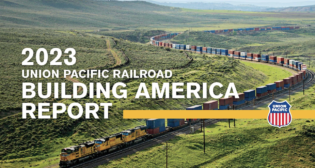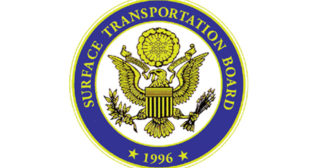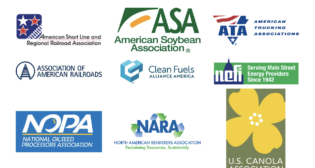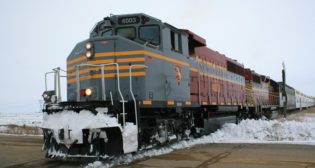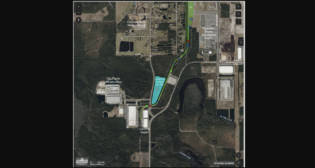
May 8, a Pivotal Day, Then and Now
Written by Chuck Baker, President, ASLRRAMay 8 is a big day in railroad history. The transcontinental railroad was completed on May 8, 1869. It was a remarkable achievement that profoundly changed the country by opening the western United States to travel and making commerce possible on a vastly larger scale.
This year, May 8 is Railroad Day on the Hill. Although perhaps not as consequential as completing the transcontinental railroad, this is the freight railroad industry’s best opportunity to communicate with members of Congress about the benefits of the national railroad network and the importance of promoting policies that strengthen that network. This annual event brings together hundreds of individuals from the railroads and rail supply industry for a single day of more than 300 Congressional office meetings. It is a display of the industry’s geographical reach and the chance to give elected officials the perspective of hundreds of railroad leaders from whom they don’t hear from as regularly as those of us in Washington, D.C. If you have attended in the past, you know the importance of telling our story. If you have not, we strongly encourage you to do so! You can register at https://www.aslrra.org/events/railroad-day.
The work our members have done on Railroad Day has yielded hugely beneficial results, including building Congressional support for the 45G tax credit, creating short line eligibility for CRISI grants, and funding the Short Line Safety Institute. These programs help us rehabilitate infrastructure to better serve our shippers, improve safety to better protect our workers and communities, preserve rail service and jobs, and maximize the significant environmental benefits of moving freight off the highway.
ASLRRA launched the first Railroad Day in 1994, and it has grown from a relatively modest short line lobbying effort into a major industrywide event. It continues and grows because lobbying Congress cannot be a “one and done” effort. Issues continue to evolve and are impacted, for better or for worse, by current events. Technology continues to change, creating new opportunities for improvement and challenges in adoption. Finally, Congressional membership itself is never static. In 2022, more than 80 new representatives and senators were elected to Congress, and that kind of turnover occurs every two years. Congressional staff turnover is even greater, and these are the individuals we depend on daily for navigating the legislative process.
This year’s Railroad Day will focus on issues that directly impact short line viability and the ability to provide reliable service to rail shippers.
The five-year infrastructure bill provided $1 billion per year in guaranteed funding and authorized Congress to appropriate an additional $1 billion per year. This year, the President’s budget recommends only $250 million beyond the guarantee, and we need to convince Congress that increasing the funding is well worth the investment. One great way to make that case is for short lines that have CRISI projects to show up on Railroad Day and describe the real-world benefits of that spending.
This year, there is yet another legislative effort to increase truck size and weights. The MOVE Act (HR 7496) would give governors new authority to increase weights without limit based on a wide range of vague “emergency” conditions or equally vague “supply chain function” disruptions. Last year, the House T&I Committee approved a 10-year “pilot” project to increase truck weights from 80,000 to 91,000 pounds. For years, the railroad industry and allied labor, trucking, and safety groups have successfully convinced Congress to reject efforts to increase truck size and weights. Last year’s T&I approval of the pilot project proposal should serve as notice that the current Congress is not as supportive as before. Participating in Railroad Day is the best way short lines can help.
A California Air Resources Board (CARB) rulemaking would impose immediate and ruinously large financial charges on railroads operating locomotives in California based on the locomotive’s emissions. The rulemaking further proposes to ban the operation of locomotives older than 23 years by 2030. While this is a state initiative, it would have catastrophic national implications immediately because of the size and importance of California. Other states may also follow, creating a patchwork of locomotive operational requirements that is untenable for the interconnected U.S. freight rail system. We are working to ensure that EPA and Congress understand the grave implications of approving a waiver necessary for this rulemaking to go into effect. Railroad Day is an opportunity to educate Congress on this issue.
The 45G Short Line Rehabilitation Tax Credit was first enacted in 2004 and remains in place. The tax credit, which must be matched by a short line’s own spending on track improvements, has been enormously successful in increasing infrastructure investment and improving safety. However, the 2004 law capped the value of the tax credit at $3,500 per mile, and $3,500 just doesn’t buy what it used to. ASLRRA is launching an effort to raise the cap in line with inflation and make new short line miles eligible.
The Transcontinental Railroad Golden Spike ceremony celebrating the May 8 completion did not go entirely to plan. Central Pacific President Leland Stanford and Union Pacific Vice President Thomas Durant used a silver-plated spike maul to gently tap in the final golden spike to not scratch the maul or the spike. The spike was then removed, and the two executives were given an iron spike and an iron spike maul that were both wired to the transcontinental telegraph line so the nation could hear the blows as the spike was driven. Stanford took a mighty swing at the spike but hit the tie instead. Durant did not even hit the tie. According to the newspaper account, “Finally, a regular rail worker drove home the last spike and the Western Union telegrapher sent the long-awaited message, D-O-N-E.”
